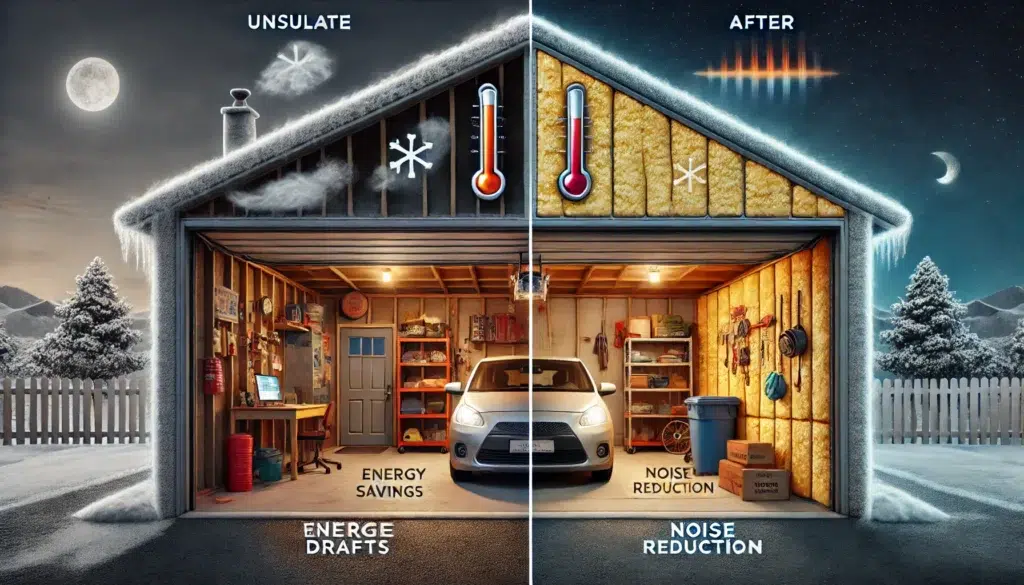
What is the Best Way to Insulate a Garage Door?
Insulating your garage door is one of the most effective ways to improve energy efficiency, enhance comfort, and even boost the overall value of your home. An insulated garage door can regulate the temperature inside your garage, protect stored items, and reduce energy bills by maintaining the internal climate. Insulation can make a significant difference if you use your garage as a workspace, gym, or simply for storage.
This article will explore the best ways to insulate your garage door, the types of garage door insulation Kit available, and the step-by-step process for doing so yourself.
Why Insulate Your Garage Door?

Before diving into the insulation process, it’s essential to understand why insulation is beneficial. Here are some key reasons:
- Energy Efficiency: Garage doors are typically large and often not insulated, allowing outside temperatures to influence the garage and adjacent rooms. Insulating the door helps keep your garage cooler in summer and warmer in winter, reducing energy loss.
- Comfort: If you spend considerable time in your garage, insulation makes the space more comfortable by minimizing temperature fluctuations.
- Noise Reduction: Insulation can also dampen noise from outside, making the space quieter for work or relaxation.
- Protection for Stored Items: If your garage stores temperature-sensitive items like paint, tools, or vehicles, insulation can protect them from extreme temperature changes.
Types of Garage Door Insulation

There are several types of insulation materials suitable for garage doors:
- Polystyrene Foam Boards:
- Best For: DIY projects and standard flat-panel garage doors.
- Pros: Affordable, lightweight, and easy to cut. These boards fit between the panels and offer decent insulation.
- Cons: They don’t have a finished look so that they may require additional coverings.
- Reflective Insulation:
- Best For: Warmer climates where reflecting heat is the priority.
- Pros: Thin, lightweight, and easy to install. Reflective insulation uses aluminum foil to reflect heat.
- Cons: Offers less insulation value in cold climates.
- Polyurethane Foam:
- Best For: New garage door installations.
- Pros: Provides the highest insulation (R-value) due to its ability to fill gaps. It’s often pre-installed in high-end garage doors.
- Cons: It’s difficult to install in existing garage doors unless you purchase a pre-insulated door.
- Batt Insulation:
- Best For: DIY projects and flexible applications.
- Pros: Inexpensive and effective, especially when paired with a vapor barrier.
- Cons: It can be difficult to cut and fit precisely, leading to potential air leaks.
Tools and Materials You’ll Need
To get started on your garage door insulation project, gather the following tools and materials:
- Insulation material of your choice (e.g., foam boards, reflective sheets, or batt insulation)
- Measuring tape
- Utility knife
- Straightedge (for precise cutting)
- Adhesive or double-sided tape (for securing insulation)
- Safety gloves and goggles
- A stapler (for batt insulation)
- Rigid foam insulation panels (optional for additional insulation)
How to Insulate Your Garage Door: Step-by-Step Guide
- Measure the Garage Door Panels: Measure each panel on your garage door. Accurate measurements are needed to cut the insulation material to fit snugly within each panel.
- Cut the Insulation Material: Use a straightedge and utility knife to cut your insulation material according to the panel measurements. Aim for a snug fit, leaving no gaps that could reduce the insulation’s effectiveness.
- Attach the Insulation:
- For Foam Boards or Reflective Sheets: Use adhesive or double-sided tape to secure the insulation within each panel. Ensure it is flush against the surface and does not bow out.
- For Batt Insulation: Staple the insulation to the panels, ensuring the vapor barrier faces outward. Avoid compressing the material too much, as this can lower its R-value.
- Seal Any Gaps or Cracks: Inspect the garage door’s edges and frame for any cracks or gaps. Use weatherstripping or sealant to fill in these spaces and prevent air from entering or escaping.
- Consider Additional Insulation: After securing the primary insulation, you can attach rigid foam insulation panels over the garage door for an extra layer of insulation. These panels are lightweight and provide additional protection from heat loss.
- Test the Door: After installation, test the garage door’s operation. Ensure the added insulation does not interfere with the door’s opening and closing mechanism.
Additional Tips for Insulating a Garage Door
- Check the R-value: The R-value indicates the effectiveness of the insulation material. The higher the R-value, the better the insulation. For garage doors, an R-value between 8 and 16 is typically ideal.
- Insulate the Garage Walls and Ceiling: For maximum comfort and energy savings, consider insulating the walls and ceiling of your garage as well. This is especially important if your garage is attached to your home.
- Upgrade to a Pre-Insulated Door: If your current garage door is old and poorly insulated, consider upgrading to a new one. Modern insulated garage doors offer superior thermal protection and require less maintenance.
Frequently Asked Questions (FAQs)
- What is the best insulation material for garage doors?
The best insulation material depends on your needs and climate. Polyurethane foam offers the highest insulation (R-value), while polystyrene foam boards are more affordable and easier for DIY installations. Reflective insulation is ideal for warm climates where reflecting heat is a priority.
- How much does it cost to insulate a garage door?
The cost varies depending on the insulation material and whether you do it yourself or hire a professional. For a DIY project, expect to spend between $50 to $200 on materials. Depending on the garage door size and insulation type, professional installation can range from $300 to $600.
- Will adding insulation affect my garage door’s operation?
Insulation should not interfere with your garage door’s operation if installed correctly. It’s important to ensure that the insulation fits snugly within the panels and does not add significant weight that could strain the opener.
- What is the ideal R-value for garage door insulation?
An R-value between 8 and 16 is generally recommended for garage doors. The higher the R-value, the better the insulation will maintain a consistent temperature inside your garage.
- Can I insulate an old garage door or buy a new one?
You can insulate an older garage door, especially if it’s in good condition. However, if your door is outdated, damaged, or poorly insulated, investing in a new pre-insulated garage door may be more effective for better energy efficiency and durability.
Conclusion
Insulating your garage door effectively improves energy efficiency, comfort, and even security in your home. Whether you opt for a DIY solution or invest in a new pre-insulated garage door, the benefits are undeniable. By choosing the right insulation material, carefully installing it, and sealing any gaps, you can create a more controlled environment in your garage that suits your needs.
Taking the time to insulate your garage door can provide long-term energy bills savings while creating a more functional space in your home.



